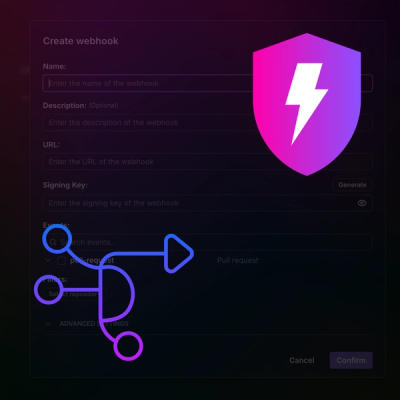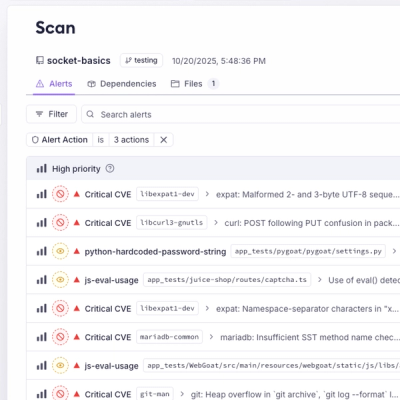
Product
Introducing Webhook Events for Pull Request Scans
Add real-time Socket webhook events to your workflows to automatically receive pull request scan results and security alerts in real time.
sxapi-core
Advanced tools
sxapi-core is an simple and extensible framework for building microservices API using javascript technologies
sxapi for simple and extensible api (Application Programming Interface) is an an open-source framework for quickly building simple and small API based on microservice architecture.
Very light (application less than 100Ko, full container stack for less than 30Mo) and configured with a single json file, you can build instantly small atomic API endpoints as well as fully featured enterprise-sized API.
The npm module using the sxapi-core npm module published in npm public registry is the best solution if you plan to develop your own component or embed you api into another application, you should be more interested by the npm method. For more information on how to run your first sxapi application using sxapi npm module, please read the npm module user guide
The simplest and fastest way to get a running sxapi application is to use the public docker image. Read the docker image user guide
If you plan to extend sxapi-core, please read the source code user guide
Theses command are for a Red Hat Linux like
environement (Fedora, CentOS, RHEL, Suse). Please adapt yum command to the
apt-get equivalent if you are using a Debian like system (Ubuntu, Debian)
sudo yum install -y nodejs npm
For more information on how to install and execute a nodejs environment, please see the official npm install guide
To run you test in a sandbox, you should isolate your sxapi test from your current work by creating a working directory.
mkdir ~/test-sxapi
cd ~/test-sxapi
Use npm command to create your package.json file and add sxapi npm module as a dependency.
For more information on how to create a npm package, you can read the
npm init documentation
npm init --force
// answer dynamic questions or type multiple time <enter>
npm install sxapi-core --save
Create a file named sxapi.json
vi ~/test-sxapi/sxapi.json
Edit it with the following content
{
"name": "sample-api",
"description": "my sample api using sxapi-core framework",
"version": "0.0.0",
"debug": true,
"log": {
"filters": {
"level": "0,1,2,3,4",
"type": "debug,info,error,warn"
}
},
"server": {
"endpoints": [
{
"path": "/",
"body": "<html><head></head><body><h1>My sample API</h1></body></html>"
}
]
}
}
You can change name, description, version and
server.endpoints.body with personalized content
In order to start your application and execute your api, you need to create a server application file. Default file is index.js when creating package.json.
vi index.js
in you index.js, add the following lines
/* global require, process, $log, $timer */
var $app = require("sxapi-core").app;
$app.launch(function () {
$log.info("application started");
});
node index.js
Connect to http://localhost:8080/ with your favorite navigator. You should
see an html message "My Sample API".
sxapi-core come with many components to help you build your own api. As soon as
you have an api instance working, you should focus on making change to your
sxapi.json config file and implement api endpoints you want to create.
To help you understand how you can configure your api, you can :
If you want to have more information on how to install, develop and run this framework and use it in your project, please read the full documentation or our user guides sections :
If you run into difficulties installing or running sxapi, please report issue for installer or issue for sxapi.
Please read contributing guide for details on our code of conduct, and the process for submitting pull requests to us.
This project is mainly developped by the startx dev team. You can see the complete list of contributors who participated in this project by reading CONTRIBUTORS.md.
This project is licensed under the GPL Version 3 - see the LICENSE.md file for details
FAQs
sxapi-core is an simple and extensible framework for building microservices API using javascript technologies
We found that sxapi-core demonstrated a not healthy version release cadence and project activity because the last version was released a year ago. It has 1 open source maintainer collaborating on the project.
Did you know?

Socket for GitHub automatically highlights issues in each pull request and monitors the health of all your open source dependencies. Discover the contents of your packages and block harmful activity before you install or update your dependencies.

Product
Add real-time Socket webhook events to your workflows to automatically receive pull request scan results and security alerts in real time.

Research
The Socket Threat Research Team uncovered malicious NuGet packages typosquatting the popular Nethereum project to steal wallet keys.

Product
A single platform for static analysis, secrets detection, container scanning, and CVE checks—built on trusted open source tools, ready to run out of the box.